How You Can Profit from the Latest Stock Market Warning Sign
Stock-Markets / Stock Markets 2011 Feb 16, 2011 - 09:26 AM GMTBy: Claus_Vogt
 There is no denying that the emerging world — especially China, India, and Brazil — has had a nice growth spurt. And there are convincing reasons to expect them to continue their long-term growth stories: Favorable demographics and a shift towards more market-oriented policies.
There is no denying that the emerging world — especially China, India, and Brazil — has had a nice growth spurt. And there are convincing reasons to expect them to continue their long-term growth stories: Favorable demographics and a shift towards more market-oriented policies.
However, these long-term growth drivers do not immunize emerging economies from the business cycle … the ebb and flow of booms and recessions.
The financial system and economic crisis of 2007-2009 was followed by the largest monetary and fiscal stimulus program ever. Not just in the U.S., but on a global scale. And with more or less every government on the planet doing the same thing at the same time, the results should also look quite similar.
Restrictive Monetary Policy Leads to Declining Stock Markets
The short-term growth effects of these policies were especially strong in emerging economies. Their stock markets made a roaring comeback — but so have inflationary pressures. Hence officials have started to implement restrictive monetary policy measures.
They’re hiking interest rates and have massively increased reserve requirements. This shift to a more restrictive monetary policy has already shown some effects.
Financial markets usually react long before the economy or inflation rates start doing the same. Emerging economies’ stock market indices have stopped rising, and are actually declining as you can see in the charts below of China, Hong Kong, India, and Brazil.
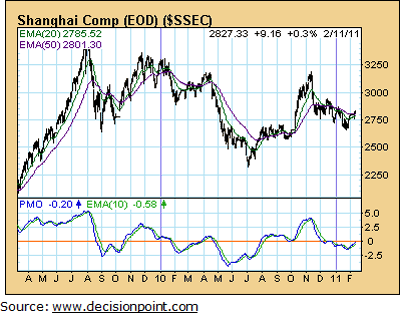
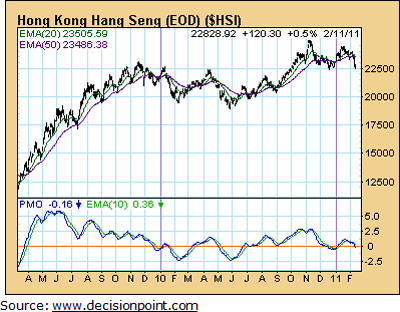
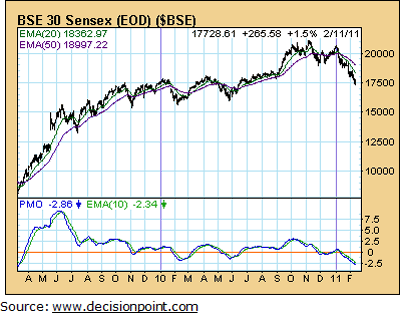
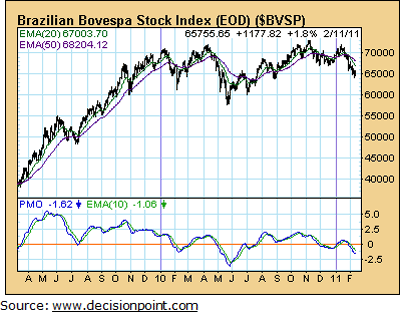
History shows that most bull markets die when central banks shift to a restrictive policy. Yet rising food prices are of greater concern than declining stock prices for emerging economies’ politicians. Therefore, I expect even more interest rate hikes to come, no matter how the stock markets react.
So instead of propping up stock prices like Ben Bernanke’s Federal Reserve has done, emerging market central banks have made controlling inflation a top priority.
Opportunity in the Making
At the end of 2008 emerging economies’ stock markets showed relative strength compared to the U.S. and Europe. They didn’t fall to new lows in March 2009. This relative strength was the harbinger for the huge rally that was to come.
Now they exhibit relative weakness and are not joining the U.S. and Europe in making new cyclical highs. And today’s relative weakness may very well turn out to be a harbinger of the next cyclical bear market in the offing.
The stock indices of Hong Kong, India, and Brazil have just hit key support levels. Consequently, a short-term rally may pop up. If so, you should consider it an opportunity to profit from the continuation of what looks like the early part of a cyclical bear market.
ProShares Ultra Short MSCI Emerging Markets (EEV) could help you make the most of that opportunity. EEV seeks daily investment results that correspond to twice the inverse of the daily performance of the MSCI Emerging Markets Index. So for every 1 percent the index declines, you stand to make 2 percent.
The U.S. Stock Market Is Even More Vulnerable!
Year-to-date the S&P 500 is up 5.6 percent. It’s up 13.2 percent since late November and 26.7 percent since late August, when Fed chairman Bernanke first announced QE2. According to Bernanke himself, this huge rally is the result of his quantitative easing efforts. He is probably right, since there are very few other reasons to support a stock market rally.
Here’s why I say that …
First of all, the fundamental valuation is extremely unattractive. The PE-ratio based on 12-months trailing earnings is at 18.5 (middle panel of the chart below). And the dividend yield is down to a paltry 1.71 percent (lower panel). Both are classic valuation metrics. And both are telling me that stocks are poised to deliver dismal long-term results.
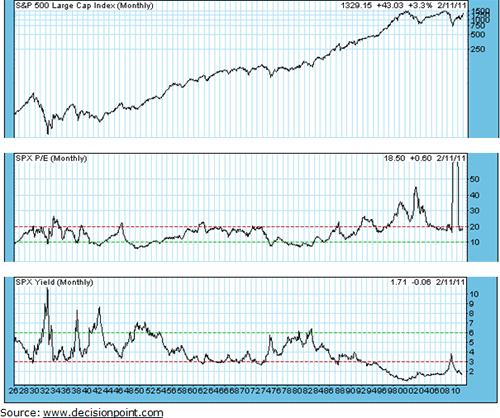
Second, sentiment indicators are telling us that bullish expectations have reached extremes. According to the Investment Company Institute, mutual fund cash levels are down to 3.5 percent. They got that low only once, in early 2010, shortly before the flash crash of May 6, which started a 20 percent correction and got Ben Bernanke to announce QE2.
Third, the stock market is extremely overbought. Momentum indicators of nearly all time frames are stretched to the point where a bigger correction has to be expected.
Fourth, longer-term interest rates have risen considerably since mid-2010. Rising interest rates and a stock market rally at the same time has historically been a rare coincidence. And when it did occur, usually it wasn’t long until stocks caved in to the pressure of rising rates. This is especially true when stock market valuations were high, markets were overbought, and irrational exuberance reigned — as is currently the case.
For the third time in a dozen years the U.S. stock market qualifies as a bubble ready to burst. And emerging markets’ relative weakness can be interpreted as a warning sign that the party may be over soon.
Best wishes,
Claus
P.S. Do you want to learn more critical background information about asset bubbles, money printing, opportunistic central bankers, and government debt and what this all means for your financial health? Then I suggest you get a copy of my new book, The Global Debt Trap. Click on your choice of bookseller to order it online — Amazon, Barnes & Noble or Books-A-Million — or stop by your nearest bookstore.
This investment news is brought to you by Money and Markets. Money and Markets is a free daily investment newsletter from Martin D. Weiss and Weiss Research analysts offering the latest investing news and financial insights for the stock market, including tips and advice on investing in gold, energy and oil. Dr. Weiss is a leader in the fields of investing, interest rates, financial safety and economic forecasting. To view archives or subscribe, visit http://www.moneyandmarkets.com.
© 2005-2022 http://www.MarketOracle.co.uk - The Market Oracle is a FREE Daily Financial Markets Analysis & Forecasting online publication.



